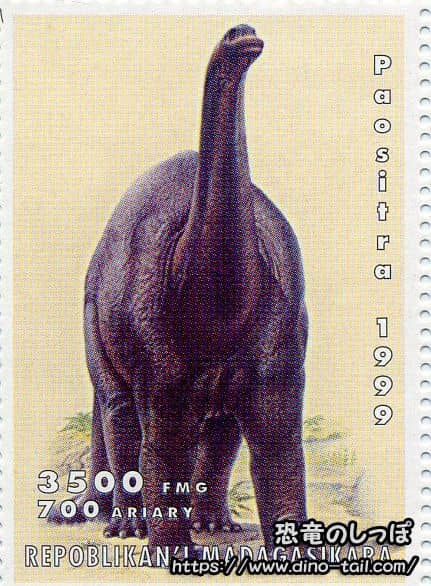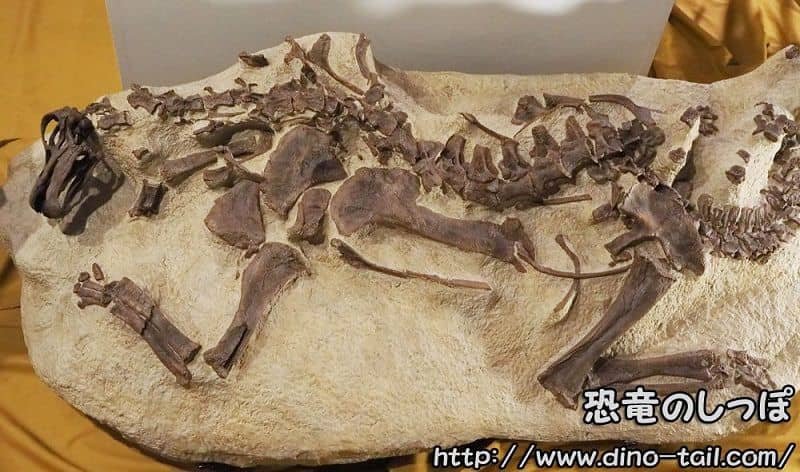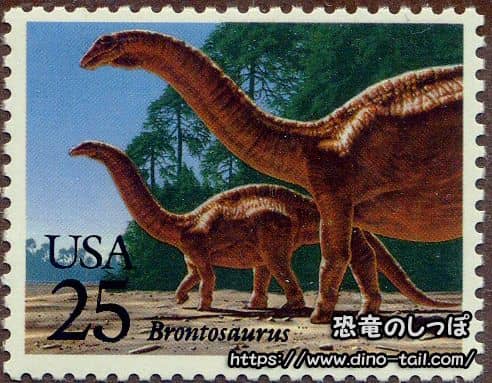About Apatosaurus
| Scientific Name (Genus) | Apatosaurus |
| Meaning of Name |
Deceptive lizard
apatē (deceptive) [Greek] - saurus (lizard) [Greek] |
| Classification | Saurischia, Sauropodomorpha, Diplodocidae |
| Total Length | Approx. 21-23m |
| Diet | Herbivorous |
| Period | Late Jurassic (approx. 152-151 million years ago) |
| Sub-classification/Species |
Apatosaurus ajax
Apatosaurus louisae |
| Year of Paper Publication | 1877 |
| Genus Name Publication | Marsh, Othniel Charles (1877). Notice of new dinosaurian reptiles from the Jurassic formation. American Journal of Science and Arts. |
A Giant Sauropod of the Jurassic Period
Apatosaurus was a massive sauropod of the Diplodocidae family that lived in North America during the Late Jurassic period. It was characterized by a stocky, thick neck and a robust body, with an estimated weight exceeding 20 tons. Its scientific name means "deceptive lizard," derived from the fact that its discovered bones were initially difficult to distinguish from those of the marine reptile Mosasaurus.

Skeletal studies have revealed that, contrary to previous beliefs, it could not hold its neck high like a swan but rather held it straight forward, nearly parallel to the ground. Therefore, it is thought to have fed on low-lying ferns rather than the leaves of tall trees.
Furthermore, since Apatosaurus did not have complex teeth, it is believed to have used "gastroliths" (stomach stones) to aid digestion. These stones would grind up plant matter in its stomach.
A Tail That Didn't Break the Sound Barrier and Incredible Growth

Similar to a Diplodocus skull, but more robust.
The tail of Apatosaurus was extremely long, tapering to a whip-like shape. It is thought to have been a powerful weapon for self-defense against predators like Allosaurus.
In 1997, it was suggested that by cracking the tip of its tail at speeds exceeding the speed of sound (about 340 m/s), it could generate a cannon-like sonic boom, and this sound might have been used for communication with its kind. However, a 2022 simulation using multibody dynamics analysis showed that the tail could only be swung at about 33 m/s (approx. 120 km/h). Although it did not reach the speed of sound, this doesn't mean the Apatosaurus's tail was useless.
A tail swung at 120 km/h, even without producing a sonic boom, would have been a formidable defensive weapon, capable of delivering a powerful blow to predators like Allosaurus.

Studies of bone growth rings have shown that Apatosaurus grew at a phenomenal rate. Hatchlings were only about 30 cm long, but they experienced a rapid growth spurt between the ages of 8 and 12, gaining up to 5 tons in weight per year during this period. They reached a massive size of over 20 meters in length in just about 15 years, after which their growth slowed. This rapid growth is considered a survival strategy to quickly outgrow potential predators.
The Brontosaurus Naming Issue

Labeled as Brontosaurus
Apatosaurus has long been confused with the famous "Brontosaurus" (Thunder Lizard). Apatosaurus was named in 1877, and Brontosaurus two years later in 1879, both by paleontologist Othniel Charles Marsh. However, in 1903, it was concluded that Brontosaurus was merely a juvenile Apatosaurus. Based on the "Principle of Priority" in the International Code of Zoological Nomenclature, the name was unified under the first-named Apatosaurus, and the name "Brontosaurus" was officially retired.
Despite the scientific decision, the name "Brontosaurus" became deeply embedded in popular culture through books, movies, and toys due to its appealing and powerful sound, and the invalid name "Brontosaurus" continued to be used until around 1990.
However, in 2015, a study re-examining a vast number of specimens concluded that "Brontosaurus is a distinct genus with different skeletal features from Apatosaurus," and the genus name "Brontosaurus" was reinstated after 112 years. This theory is still contested, and the debate continues among experts.
Understanding Apatosaurus Through Comparison with Relatives

Labeled as Brontosaurus
To deeply understand what kind of dinosaur Apatosaurus was, it is essential to compare its form with other sauropods, especially its close relatives that lived in the same time and region. This comparison highlights the unique physical characteristics of Apatosaurus and the ecological role they suggest.
Comparison with Diplodocus: "Robust" vs. "Gracile"
Apatosaurus belongs to the Diplodocidae family and is very closely related to Diplodocus, a representative member of the same family. Both had a horizontal body plan with long necks and whip-like tails, but there were clear differences in their build.
The biggest difference was their "robustness." Although Apatosaurus was shorter in length at about 21-23 meters compared to Diplodocus's over 27 meters, it is estimated to have been much heavier. One study estimates the weight of Apatosaurus at about 33 tons, while Diplodocus is thought to have weighed at most 18.5 tons.
This size difference is due to their skeletal structure. It is believed that while they shared the same environment, they utilized different food resources or had different defensive strategies against predators.
Comparison with Brachiosaurus: Differences in Body Shape and Diet
Let's compare it with a more distantly related sauropod, Brachiosaurus.
Brachiosaurus had a completely different body shape from Apatosaurus. Its most prominent feature was that, like a giraffe, its forelimbs were significantly longer than its hind limbs. This elevated its shoulder position, causing its neck to naturally point upwards at an angle.
This strongly suggests that Brachiosaurus was a "high-browser," primarily feeding on leaves from tall trees. In contrast, the lengths of the forelimbs and hind limbs of Apatosaurus were relatively similar, and its entire body was held in a posture nearly parallel to the ground. This indicates that Apatosaurus was a "low-to-mid browser," moving its neck horizontally to feed on plants over a wide area at low to medium heights, rather than reaching high up like Brachiosaurus.
Comparison with Titanosaurs: Jurassic Giants vs. Cretaceous Giants
Let's make a comparison across eras. Several tens of millions of years after the Late Jurassic when Apatosaurus lived, the Cretaceous period saw the emergence of even larger titanosaurs, such as Patagotitan and Argentinosaurus.
Compared to these Cretaceous giants, even the massive Apatosaurus seems small. For example, the estimated weight of Patagotitan exceeds 60 tons, more than double that of Apatosaurus. This comparison shows that the trend towards gigantism in sauropod evolution peaked in the Cretaceous.
While Apatosaurus was one of the largest dinosaurs of the Jurassic, in the context of the entire dinosaur era, it can be positioned as an important stage in the evolutionary lineage of gigantism.
